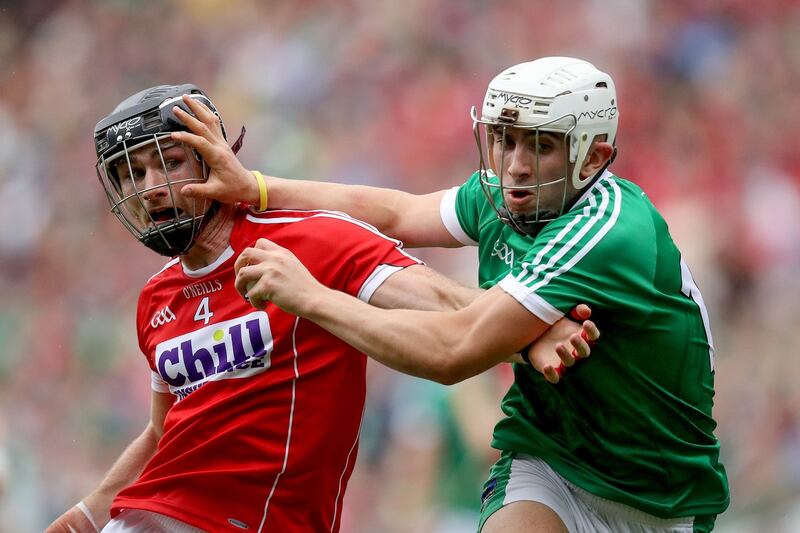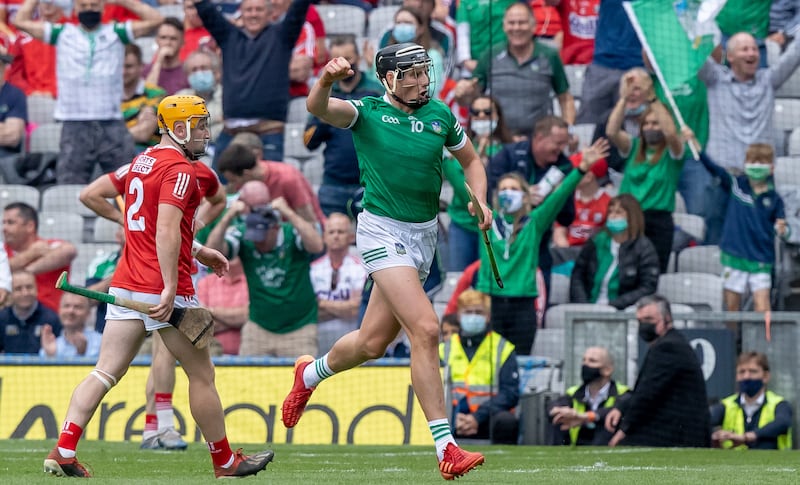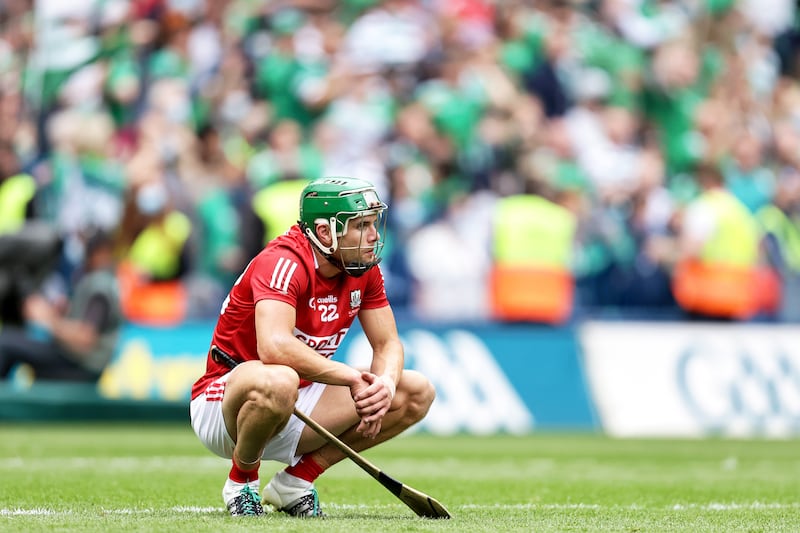Two days in Croke Park, three years apart. What do they matter now? What did they mean then? For Limerick, it was their journey from maybe to definitely. And Cork? Marooned on maybe.
Cork suffered. Limerick beat them in the 2018 All-Ireland semi-final when Cork were six points clear with eight minutes and 17 seconds of normal time remaining. They floored them in the 2021 All-Ireland final when Cork brought a knife to a gunfight and Limerick were halfway to being the greatest team of all time.
For Cork, it is tortuous to remember – on their way to where they are now, it would have been reckless to forget. The bloody cuts settled on their flesh as scars. Against future attacks the only viable defence was change. That took time.
For the last half a dozen seasons Limerick have held up a mirror to all-comers. Ultimately, that was the only reflection that mattered. How did Limerick make you look? How did they make you feel? What did they make you think? And think again?
RM Block
In John Kiely’s time, Cork and Clare are the only teams to have beaten Limerick home and away, in league and championship. Croke Park, though, was different: it was a neutral space that Limerick colonised and occupied. They planted their flag.
The 2018 match has a resonance still because of the elements that shaped it in the end. Cork’s game management failed them. Limerick were still working that stuff out, but they were cool down the stretch against Kilkenny in the quarter-final, and they didn’t blink when Cork put a gun to their heads. That kind of confirmation has a cumulative effect.
But it was in Cork’s hands. They dropped it.
“It was definitely the biggest regret of any game in my career that we didn’t hold on to win because I think we would have won the All-Ireland that year,” says Colm Spillane, the former Cork defender. “It’s one of those games you’d always regret.”
When Limerick fell six points behind Michael Duignan said in the RTÉ commentary that they would need a goal. The relationship in hurling between goals and points has changed profoundly in the last seven or eight years and Limerick were drivers of the new exchange rate. In the event, they scored seven points without reply.
“Croke Park feels like a big pitch when the other team has a lot of the ball and they’re winning puck-outs and you feel like the ball is hammering in on you the whole time,” says Spillane.

After Darragh Fitzgibbon burst through for a point in the 62nd minute Cork didn’t score from play again for the next 27 minutes, stoppage-time and extra-time included. They were swept out on a rip tide, unable to swim against it. In the middle of Limerick’s scoring burst Bill Cooper went down, looking for medical attention, nothing wrong with him except worry.
“I was just trying to slow it down,” Cooper says now, “but I don’t think the ref gave us too much time. It is very hard to turn momentum when you’re in the thick of it. You really need somebody to step up and get a score.”
Patrick Horgan hit the upright. Tim O’Mahony launched a speculative shot from 80 metres. No score. Duignan passed a remark on the screaming body language. “Cork are struggling for inspiration. Nobody went for that last puck-out at all. Who wants it the most?”
The sides were level in the second minute of stoppage-time when Nickie Quaid made his everlasting block on Séamus Harnedy. Overlooked in that moment was Limerick’s scramble defence. Quaid lunged at Harnedy from the edge of the small square, but lined up behind the Limerick goalkeeper were three Limerick defenders and right behind Harnedy was a fourth, desperately trying to make a hook. In the years that followed such portraits of resistance would be repeated in a thousand different poses.
The game was decided by subs. Limerick’s bench boost became a cliche soon afterwards but not yet. That day they contributed 2-6, 1-4 from play; Cork’s subs came up with a point.
Their lack of squad depth had been a recurring issue all season and that day it was unsustainable. Daniel Kearney and Harnedy, two of Cork’s best players, came off and went back on again. Kearney was plainly injured and in extra-time he was replaced for the second time.
“We never got going in extra-time,” says Spillane. “I’m not sure why. Maybe we were so deflated that we lost the lead or something. Daniel Kearney and Séamus Harnedy, in fairness to them they had played brilliant games and they brought them back on – something that doesn’t happen nowadays. We probably needed fresh legs.
“I had a tough afternoon. Probably the toughest match I played, to be honest. Aaron Gillane caught a couple of balls over me in the first half, but you were very wary of him getting in behind, so I probably gave him a bit too much space. I knew at the time he was a very good player but he showed afterwards how good he actually was.”

That was the thing: in 2018, nobody knew how good Limerick would become. It was unforeseeable. Unimaginable. By 2021, there were no mysteries. Limerick were a known quantity. Decipherable. Formidable. Forceful. Brilliant. Daunting. Overbearing.
Cork arrived in Croke Park with a head of steam. “We were after a cracking win against Kilkenny in the semi-final [after extra-time],” says Cooper. “You were going up with a bit of hope.”
Around Cork the hype was intoxicating. “It’s not making excuses, but I would put a lot down to the fact that Cork hadn’t been in an All-Ireland final in a long time [eight years],” says Dónal O’Grady, former Cork player and manager who was part of Cork’s backroom team that year. “Two weeks was a short time to come down from the match against Kilkenny and get back up again. That was a factor.”
Cork had reached Croke Park on a high calorie diet of pace and stickwork and all-out attack. It was exhilarating and one-dimensional. What they lacked, as a group, was aggression and power. There were a handful of exceptions but not nearly enough to tip the balance.
Cork were conscious of it. A week before the All-Ireland final they played an A versus B game in Fota Island where only one free was awarded. They were trying to condition themselves for the onslaught to come but that kind of simulation was beyond their capacity. They weren’t a team that played with force. They couldn’t inflict it on one another.
“I don’t think the way Cork trained before that match was anyway like the way Limerick trained,” says Brian Fitzgerald, who was part of Cork’s analysis team. “In the A versus B game, the B lads weren’t hitting them. I know in Limerick, the week before that final, they had a game in the Gaelic Grounds where the B team beat the A team by a point and there could have been a full-on brawl. When I worked with Munster [rugby], if Munster were up for a European match there was a fight that week in training.”
In terms of strength and conditioning Cork were years behind. O’Grady, who had spent time in Limerick a decade earlier, says S&C programmes were in place back then, from the academy teams upwards. He knew that wasn’t the case in Cork.
Christy O’Connor, the journalist and coach, was part of Cork’s backroom team that year as well. “I was over near the tunnel in Croke Park just at the time Limerick came out on to the field and I remember thinking, ‘The size of these lads, they’re absolutely massive.’ It just hit me there and then.”
The game was still alive after 15 minutes. “Cork are certainly not overawed at all by the occasion,” said Duignan in commentary. “For a young team to come here and start like this is very impressive.”
Less than 10 minutes later the game was mortally wounded. By half-time it was dead.

“I have a traffic-light system [on my computer] for different in-game stats,” says Fitzgerald. “Green, amber, red. Based on whatever the percentages were [for key metrics] my screen would turn different colours. That day, my whole screen literally went red [in the first half]. The first marker you will look at is workrate. I don’t know, maybe it was the occasion, maybe they were overawed.
“In the dressingroom at half-time the most you’ll probably be able to fix is one thing. I don’t think there was anything the Cork management could have done that day.”
According to Limerick’s internal statistics their players had made nearly 60 tackles in the first half and Cork had made about 20. Limerick had picked off 2-5 from turnovers. In the first half alone they had 10 different scorers. The 3-18 they racked up was the biggest first-half total in the history of All-Ireland finals.
“Cork are trying to pitch a tent in a hurricane,” said Donal Óg Cusack on RTÉ.
Alan Cadogan came on as a substitute, 12 minutes into the second half. “You knew coming on the game was over,” he says. “You still couldn’t give up or show the white flag, it was just about making the scoreline some bit respectable. It’s hard to believe that you’re actually thinking that way as a Cork player.
“They out-hurled us – physically, tactically, everything. They blew us out of the water. When you get to an All-Ireland final you want to do yourself justice. We didn’t do ourselves justice.”
In the flotsam of the wreckage there was very little to cling to. “The first 20 minutes,” says O’Grady, “weren’t too bad. We gave away a goal early on that was avoidable. We gave them the ball back. But in the second quarter they finished the game. We didn’t have the wherewithal to come back at them.
“When you were watching it, it reminded me of Bord Na nÓg [juvenile] matches long ago when a team would be well ahead and the referee would blow up early. I’d say that’s the way most people felt before the end of the game.”
The world keeps spinning. Cork needed to find a way back. Limerick were still the benchmark for everything. There was no way around them.
Where are Cork now? In the Gaelic Grounds last year Cork outscored Limerick by six points in the last 10 minutes and lost by a point; in Páirc Uí Chaoimh this year they outscored Limerick by six points in the last seven minutes and won by two. They had more shots than Limerick in this fixture for the first time in five years, according to O’Connor. Cork were aggressive. They won the puck-out battle. They didn’t play with fear. Or deference.
Their athletic profile is better. Their panel is deeper. Their tackle numbers have improved: not uniformly, not every day, not to Limerick’s level; but better. Against Limerick, all that stuff gets you to the starting line. No further.
Cork suffered. They needed to learn. Change. With humility.
Limerick showed them.






















